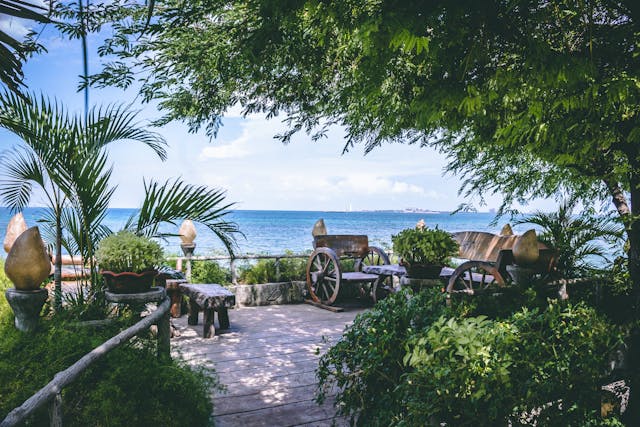What is a lanai? Discover the origin, purpose, styles, and benefits of this tropical outdoor haven that redefines relaxation and lifestyle.
What is a lanai? You may have stumbled upon this unfamiliar word in a real estate listing or heard it casually dropped in conversation by someone describing their dreamy tropical home. Maybe you Googled it right after seeing it featured on a luxury home tour in Hawaii or Florida.
Spoiler alert: it’s not just a fancy word for patio.
A lanai is a uniquely designed outdoor living space rooted in Hawaiian architecture but increasingly popular in warm-weather regions across the globe. But here’s the kicker, it’s not about luxury for show. A lanai is a philosophy of living. It’s a structural invitation to slow down, connect with nature, and live life in a fluid space that blurs the line between indoor comfort and outdoor freedom.
In this epic guide, we’re going to unpack everything you need to know about lanais, what they are, where they come from, how they differ from patios and porches, the various design styles, their unexpected benefits, and whether you should invest in one.
Article Breakdown
The Origin Story: Where the Lanai Comes From
The word lanai originates from the Hawaiian language, referring to a roofed, open-sided veranda or porch that’s attached to a home. Historically, lanais were used as a way to extend the living space into nature. This made perfect sense in a place like Hawaii, where the climate favors open-air living all year round.
But it’s more than just architectural pragmatism. Hawaiian culture places a strong emphasis on harmony with nature, community, and relaxed living. The lanai embodies that ethos. It isn’t just an add-on, it’s a lifestyle fixture.
As this concept migrated to mainland America, especially in states like Florida and California, the lanai began evolving. From simple roofed patios to luxurious enclosed lounging spaces with retractable walls and screened protection, it became both a symbol of leisure and smart architectural adaptation to climate.
What a Lanai Really Is (And What It’s Not)
Let’s get this straight: not every outdoor space is a lanai.
You can have a porch. You can have a deck. You can even have a screened patio. But a lanai is its own category. Here’s what sets it apart:
A lanai is always attached to the main home.
It’s not floating in your backyard like a gazebo. It connects directly to your house, usually through the living room, kitchen, or master bedroom, so it becomes a seamless extension of the home.
It’s often covered, and frequently enclosed.
While traditional lanais are just roofed and open-air, many modern lanais are screened or fully glass-enclosed to provide bug protection or climate control without giving up the outdoor feel.
It’s made for year-round living.
Unlike a deck that might only see use during fair weather, lanais are designed to be used daily, breakfast with birdsong, afternoon coffee, evening wine. Rain or shine.
It’s a space with intention.
A lanai isn’t just where you toss your grill and call it a day. It’s a curated environment. Think comfy furniture, mood lighting, indoor plants spilling outside, ceiling fans, and possibly even a fireplace or TV.
How a Lanai Compares to Patios, Porches, and Sunrooms
Think you already have a lanai? Maybe. Let’s play compare and contrast.
Lanai vs Patio
Patio: Ground-level, usually in the backyard, uncovered or with an umbrella. Very casual. Lanai: Attached to the home, covered, and sometimes enclosed. More structure, more purpose.
Lanai vs Porch
Porch: Typically in the front of the house, may or may not be covered. Lanai: Usually at the back or side, designed for relaxation or entertaining, with better weather protection and usability.
Lanai vs Sunroom
Sunroom: Fully enclosed, with glass or solid walls, climate-controlled. Lanai: May be enclosed but still retains that open-air feeling. Often more integrated with nature, sometimes with screens instead of windows.
So while they’re all outdoor-ish spaces, a lanai hits that sweet spot: structured yet breezy, indoors yet outside.
Why More Homeowners Are Falling in Love with Lanais
Let’s face it, we’re in an age where indoor square footage costs a premium. And yet, most people crave more space. The lanai is a strategic lifestyle hack.
Year-Round Usability
In southern climates, a lanai isn’t seasonal, it’s essential. With the right design, you can enjoy it all year, without needing to run air conditioning or worry about pests.
Increased Property Value
A well-designed lanai doesn’t just improve your life; it boosts your home’s market appeal. Buyers see it as bonus square footage and a lifestyle upgrade in one neat package.
Wellness Benefits
Natural light, fresh air, and greenery do wonders for your mental health. A lanai gives you a dedicated space to soak in vitamin D without leaving home.
Entertainment Goldmine
Hosting guests? Cooking outside? Need a safe space for the kids or pets to play? The lanai adapts beautifully, whether you’re throwing a cocktail party or reading quietly with your morning coffee.
Design Styles: No Two Lanais Are Alike
The beauty of a lanai is that it bends to fit your lifestyle. Want resort luxury? Minimalist Zen? Classic coastal vibes? Done.
Tropical Resort-Style Lanai
Think bamboo furniture, ceiling fans, palm plants, and maybe a small plunge pool or hot tub. You want it to feel like you’re on vacation, every day.
Modern Minimalist Lanai
Clean lines, neutral colors, low-profile furniture. Use natural textures like stone, concrete, or teak. Add large sliding doors that disappear into the walls.
Coastal Chic Lanai
Whitewashed wood, blue and beige tones, shell accents, and lots of light. Let the sea breeze be your designer.
Rustic Lanai
Wood beams, wrought iron furniture, earthy tones, lanterns. Cozy yet outdoorsy, great for mountain homes or countryside retreats.
Should You Build a Lanai?
If you’re reading this with even the faintest curiosity, yes, consider it. But do it smartly.
Things to Think About:
- Climate: A lanai makes the most sense in places with mild to warm climates year-round.
- HOA/Building Codes: Some areas have restrictions on attached structures. Get the green light before building.
- Budget: Costs can vary depending on materials, size, and whether you’re enclosing it or adding luxury features.
- Usage: Be honest, will you actually use it daily? Design it in a way that makes it irresistible.
And remember, lanais aren’t just for mansions or retirees. Even a modest home can support a beautiful lanai that turns your lifestyle up a notch.
Unexpected Uses for Your Lanai
Once you have one, you’ll wonder how you lived without it. Here are a few ways people transform their lanais beyond the obvious:
- Outdoor yoga or meditation space
- Reading nook or writing corner
- Work-from-home escape
- Game room with weather protection
- Mini greenhouse for tropical plants
- Rainy day hangout with cozy blankets
Because why limit something so flexible to just one function?
Real Stories: How Lanais Changed People’s Homes
Let’s break the fourth wall for a moment.
Sarah, a teacher from Naples, Florida, turned her 10×15 lanai into a homeschooling sanctuary for her two kids. “It’s the only place where they stay focused,” she says. “I think it’s the breeze.”
Meanwhile, Raj, a software engineer in California, built a lanai as a buffer between work and personal life. “I log out of Zoom, grab a drink, and walk right into a different headspace. No commute, no problem.”
These aren’t architectural trends. These are lifestyle revolutions.
Key Takings
- A lanai is a covered, often enclosed outdoor space attached to your home, distinct from patios, porches, and sunrooms.
- Originating in Hawaii, the lanai embodies a lifestyle of open-air relaxation and nature-connected living.
- Unlike patios or decks, lanais are designed for daily, year-round use and often include furniture, decor, and protection from the elements.
- They increase property value, offer wellness benefits, and serve as versatile entertainment spaces.
- Design styles are limitless, resort-like, rustic, minimalist, coastal, or anything that fits your vibe.
- Adding a lanai isn’t just an aesthetic choice, it’s a lifestyle investment that redefines how you live at home.
- Whether you want to host, relax, work, or play, a lanai adapts to your life in meaningful ways.



